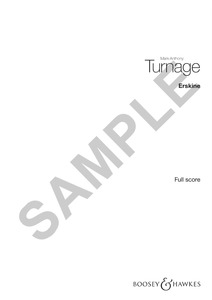Turnage, M.-A. (2013) Erskine. [Composition]
Abstract
For drum set and orchestra, duration 30 minutes. This piece was premiered on 11 September 2013 at the Beethovenhalle, Bonn, performed by Peter Erskine (percussion) and the Beethoven Orchester Bonn, conducted by Stefan Blunier. "Originally a wind player, Mark-Anthony Turnage wrote his first orchestral piece at the age of 20, while studying with Oliver Knussen. He honed his orchestral abilities under Simon Rattle as Composer in Association with the City of Birmingham Symphony Orchestra, and has become known for the color, flair, and vernacular sensibility of his orchestral compositions, which include works such as Blood on the Floor, Your Rockaby, and Hammered Out, all of which the LA Phil has performed. / "I’m interested in the physical quality of the music: not just the sound, but the effect it has," Turnage has said. "There’s a visceral quality in the music I like. There’s something you can really grab hold of, something almost physical that you can touch." / He also has a great love of jazz, and has collaborated with many jazz musicians in his works, including the master drummer Peter Erskine, who played in the world premiere of Blood on the Floor (with guitarist John Scofield) in 1996. Erskine also played in the premiere of Turnage’s Scorched (adaptations of Scofield tunes for jazz trio and orchestra), and the composer wrote a double concerto for Erskine and Evelyn Glennie, Fractured Lines, based on motifs supplied by Erskine. / Indeed, Turnage has a penchant for personalized concerted works such as Erskine, a "Concertante for Drum Set and Orchestra" that its dedicatee premiered last year with the Beethovenorchester Bonn. Its first three movements are named for the soloist and members of his family: the rambunctiously riffing "Maya and Taichi’s Stomp," which ends with an improvised cadenza; "Mutsy’s Habanera," with its insinuating orchestral solos; and "Erskine’s Blues," with its swinging triplets. / Turnage titled the finale "Fugal Frenzy," which seems a fair warning. It opens with a four-part percussion fugue for the soloist and three orchestral percussionists, and then plays muscular combination games with the full ensemble. After an improvised cadenza, the low woodwinds begin to reconstitute the original fugue in pontillistic fashion. The soloist soon joins, and pushes the polyphonic accumulation to a monomaniacal buzzsaw finish." © John Henken, courtesy of the Los Angeles Philharmonic Orchestra
Actions (login required)
 |
View Item |


![[img]](https://researchonline.rcm.ac.uk/218/1.hassmallThumbnailVersion/erskine.png)
 CORE (COnnecting REpositories)
CORE (COnnecting REpositories) CORE (COnnecting REpositories)
CORE (COnnecting REpositories)